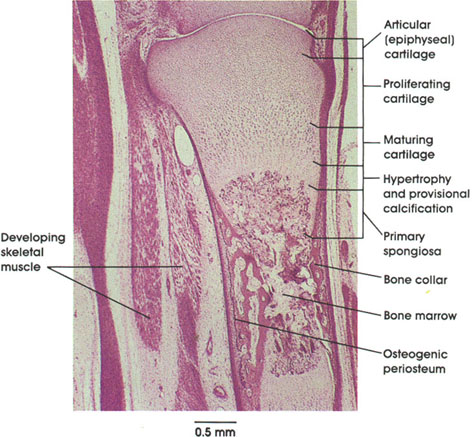

Ronald A. Bergman, Ph.D., Adel K. Afifi, M.D., Paul M. Heidger,
Jr., Ph.D.
Peer Review Status: Externally Peer Reviewed

Rodent, 10% formalin, decalcified, H. & E., 22 x.
Detail from a later stage of bone formation in which a bony collar has formed and cartilage is undergoing various bone growth-related changes. The development of a bone collar initiates the hypertrophy of cartilage cells. This is followed by a vascular intrusion into the cartilaginous core bringing along with it osteoblasts and chondroclasts from the osteogenic connective tissue perichondrium. The osteogenic cells lay down osseous tissue internally and the bony collar expands, in the long axis distally, in both directions. The structural components of the cartilage at this stage have been identified as (1) so-called resting, epiphyseal, or articular cartilage, which is adjacent to (2) proliferating cartilage, which is characterized by mitotic figures and flattened chondrocytes, which synthesize and secrete matrix. The next zone (3) is named maturing cartilage, where matrix is also synthesized and presumably prepared for calcification. The cells enlarge and accumulate glycogen; then the cells become inactive and vacuolated and the nuclei pyknotic, after which they die. This region is known as (4) the zone of hypertrophy. When the lacunae housing chondrocytes break down in the transverse plane, they form spicules of cartilage, which become calcified, resulting in the formation of (5) the so-called primary spongiosa into which capillary loops advance. The advancing blood vessels bring in osteogenic cells, which continue the calcification process and development of bone.
The formation of a mature bone involves the following developmental stages: (1) intramembranous ossification, (2) endochondral ossification, (3) growth, (4) shaping or modeling to desired shape, and (5) remodeling mature bone over time.
Next Page | Previous Page | Section Top | Title Page
Please send us comments by filling out our Comment Form.
All contents copyright © 1995-2025 the Author(s) and Michael P. D'Alessandro, M.D. All rights reserved.
"Anatomy Atlases", the Anatomy Atlases logo, and "A digital library of anatomy information" are all Trademarks of Michael P. D'Alessandro, M.D.
Anatomy Atlases is funded in whole by Michael P. D'Alessandro, M.D. Advertising is not accepted.
Your personal information remains confidential and is not sold, leased, or given to any third party be they reliable or not.
The information contained in Anatomy Atlases is not a substitute for the medical care and advice of your physician. There may be variations in treatment that your physician may recommend based on individual facts and circumstances.
URL: http://www.anatomyatlases.org/